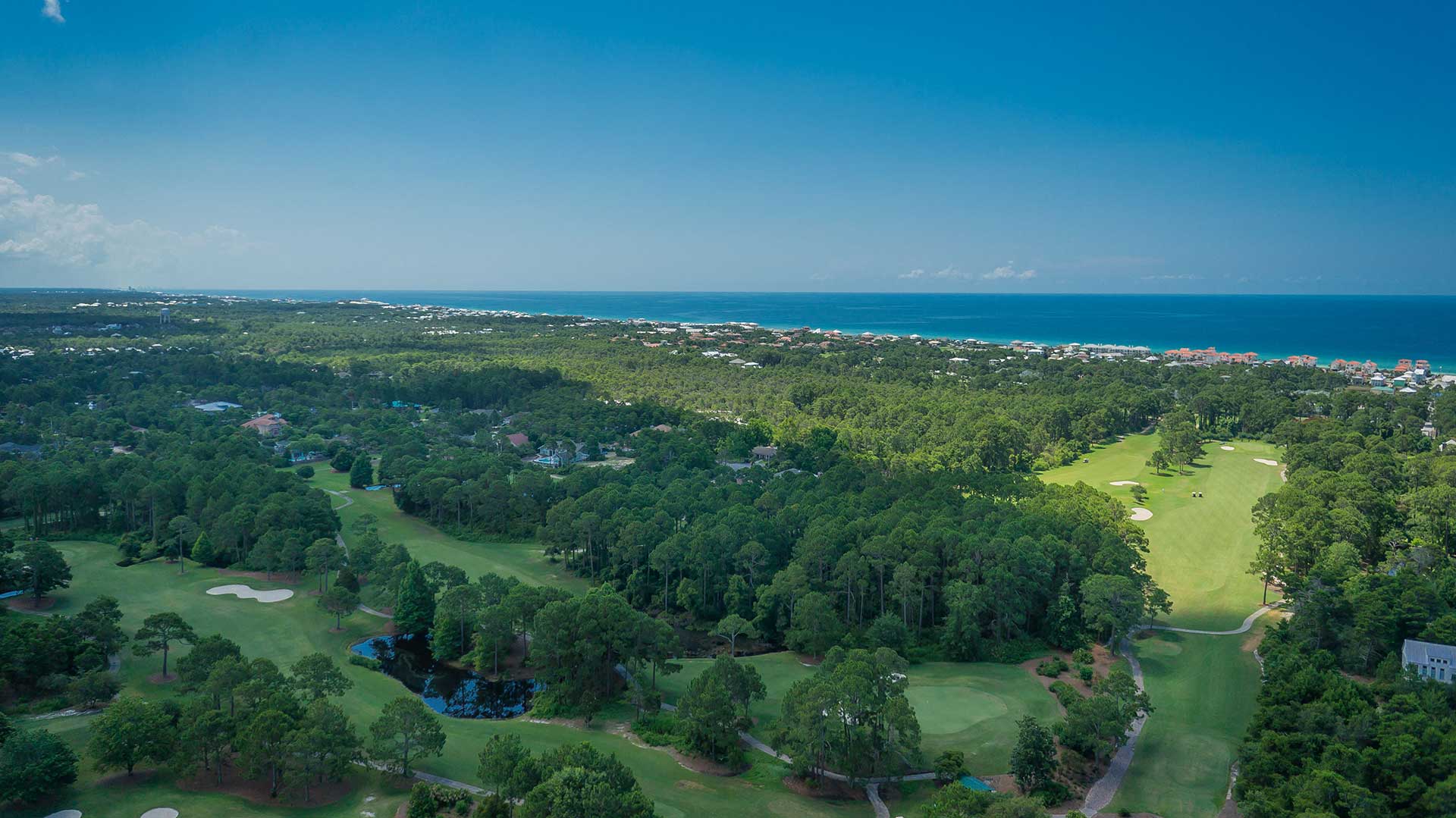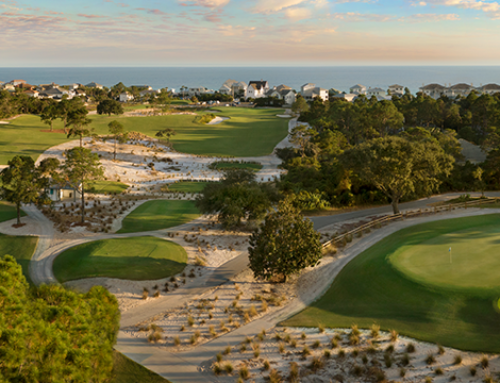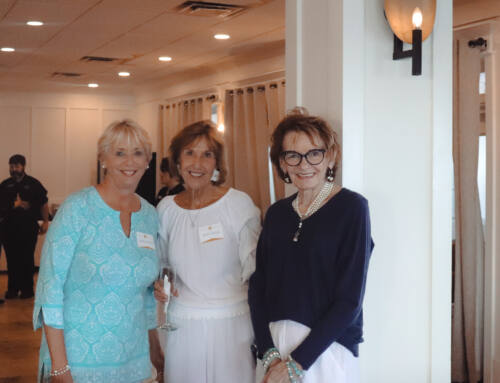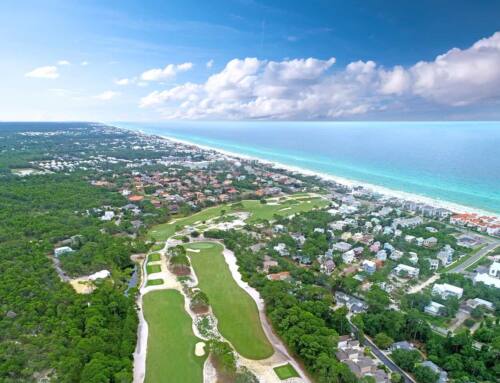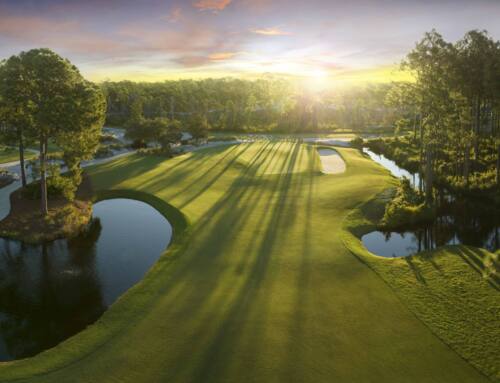The following are the club history research findings of Billy Crane, member of 30 years. He worked diligently to investigate and compile 50 years worth of Santa Rosa Golf & Beach Club facts so that we can share the rich history of the club with others. Thank you, Billy!
Early Years
The story starts before 1967. South Walton county was largely uninhabited. The large military presence in the panhandle of Florida meant that many servicemen eventually became landowners in Walton County, including quite a few high-ranking military officers. The can-do attitude that these men had created a future for development here.
In 1967 General Kees put together a steering committee to research the possibility of putting a beach club and golf course where it stands today. In October 1967, Earl Keys (retired executive from General Mills) called together generals Gorby, Morris and Pierce. He also called Howard Lucas, a petroleum engineer. They discussed the possibility of starting a golf course at Santa Rosa Beach and set up the steering committee which included Earl Kees, Alvin Gorby, Winslow Morris, Arthur Pierce, James Williams, Wilder Johnson, Murray Beasley, Eric Alan, Harold Lucas and Butler. At a subsequent meeting, the steering committee wisely decided to commission a feasibility study to prove the feasibility of building a golf course at Santa Rosa Beach. They hired Patterson Associates Inc., a firm from Gulf Breeze, Florida, who were the planners, engineers and surveyors to conduct the study. The study was completed in March of 1968 and was very comprehensive. It was also in March 1968 that they had the first annual meeting in which the articles of incorporation and bylaws were approved. They agreed to apply for a loan from the Farmers Home Administration.
On January 31, 1969, the state of Florida issued a corporate charter. Kees contacted Cassidy and Spires about land. The club received the charter in January 1969 as a regular nonprofit corporation under the laws of the state of Florida. The founders were Earl Keys (President), AL Gorby (Vice President) and Arthur J. Pierce (Secretary Treasurer). The club was created to provide golf, tennis, beach facilities and companion recreational activities for all its’ members and guests.
Recollections of Bob Bannerman
No local bank would back such a risky operation, so the founders went to the FHA because they had a provision in their charter that called for funding recreational entertainment, etc. This met all the qualifications under this requirement. They obtained a loan of $235,000 at 5% interest from the FHA. The loan went through and construction was started on both the clubhouse and the golf course itself.
We came down in 1971 and there were only three holes of golf that had been completed – all the rest were under some form of construction. The clubhouse was still in progress of being constructed. It was still in rough form and we had to struggle to find equipment, such as tractors, lawnmowers, etc. to keep the project going. We bought a Ferguson tractor which is fairly big tractor, but we needed money for more equipment so we made a deal with a bank in DeFuniak, FL for a loan. We were starting out with two debts – one with the FHA and one to the bank in DeFuniak. The whole enterprise was a very close working team. There was no saying “I’m in charge” or anything like that. It was simply a cooperative effort.
We moved a long and Kees became the first president, but he became somewhat ill – heart trouble I think. Harold Randall took over as president. We all worked together as we didn’t have much money at all. Everything we did required a coordinated effort of the members themselves. One of the first things we had to have was a pro shop and administrative shop that we could use. Winnie Morris had gotten a hold of some secondhand golf carts when he took over the job of maintaining them. We had enough money to buy the material for the pro shop, but we couldn’t give out a contract because we didn’t have that kind of money. All of us men and women got down there – we had trowels and we had cinderblocks and with the guidance of two or three people who knew something about building we put up the building.
Once the basic exterior was finished, we had to furnish it. Again, we didn’t have any money so we took contributions from members to finish the place. Being made of total concrete, it was very noisy so we finally put in a drop ceiling to help alleviate some of that and for the first time we had a livable room. The question of having a cook and staff to run the place was a monumental problem. They were hard to get and it was equally hard to find somebody who had some quality in what they were doing. We constantly had to be on alert even though one of the members was the house manager. We needed a bartender and under Florida law you could not tend bar in a public place such as the club unless you were authorized to do so. We couldn’t afford a bartender so the whole board went over to Pensacola, FL and before the proper people over there, everybody was photographed and fingerprinted and became authorized to be bartenders. When we came back we maintained a schedule that we would serve for so many hours and then somebody would step in to relieve us. Anyway, it worked.
The clubhouse was doing better and the golf course was doing very well, but we had to make many improvements on it in the meantime. Angus Andrew was the executor of the estate of the lot to the east of the clubhouse (75 feet wide and 300 feet deep). We decided we would definitely need the room for future expansion so we arranged to buy an additional 75 feet from Angus Andrews at the cost of $15,000.
After my term, we were in a position where we wanted to expand the golf course to 18 holes instead of just nine. Now it’s so happened that Jake Veeland was President of Saint Joe paper Company, and also happened that Jake was a fraternity brother of mine. Saint Joe paper company furnished us a list of pieces of property surrounding us that they would like to have, which generally was in the middle of one of their holdings. We met with the people that owned this property and tried to buy it. We got a promise of sale from them and the cost for the 50 acres. We bought the property and then deeded it over to Saint Joe. They in turn deeded over to us the 50 acres that we wanted.
Board Meeting Quotes
The following are some quoted minutes from board meetings beginning in 1987. This is when the club begin to explore the real possibility of adding a second nine holes to the golf course. It was during this time that Santa Rosa Golf and Beach Club began to be run more like a professional country club. The club had the original loan of $235,000 plus another loan to buy the additional 50 acres for the new nine. I believe that was purchased in 1984. In January of 1988, the FHA was about to call the original loan and the board was shopping for a new $550,000 loan to pay the original loan off and start on the back nine project.
February 1987: “ The membership is overwhelmingly in favor of the construction of an additional nine holes”
March 1987: “Our problem has been the loss of $40,000 per year incurred at the clubhouse”. To deal with this dilemma we have to examine the following alternatives – shut the clubhouse completely, shut the clubhouse except Friday through Sunday and for special events, cut cost and increase revenue, promote and develop a public commercial restaurant or continue to absorb the loss. We have chosen the third choice as a means of dealing with this problem.”
April 1987: “Tom Jackson, our golf course architect, has designed an exciting nine holes on the 50 acres that Bob Fleet’s administration wisely bought for us some years ago. He has also planned a pro shop, driving range and lots on the 20 acres that we are attempting to purchase. We are currently applying for permits and requesting prices to construct our golf course. I anticipate the board giving the go-ahead on this project so we can break ground in the next 60 days or so.“
“More good news! We have uncovered a half dozen or so lots on the existing golf course that are not restricted as to their use and that may be sold. We are in the process of plotting them and anticipate offering them for sale by auction at the July annual meeting. With the cash we currently have, the revenue derived from the sale of these lots and the cash from our members who exercised their option on equity membership, we should be in a financial position to just about build the new nine holes for cash if we so desire“
May 1987: “We have filed our permits to construct the additional nine holes barring unforeseen holdups. We should be able to take bids for construction in June and, pending board final approval, begin work shortly thereafter.“
“The plan called for 10 lots. Your board has decided that only six should be made available. There will be two to the right side of the first green, but with the club retaining possession of the land containing the stand of pines to the immediate right of the green. It will also be a few lots to the right. A permanent lake will be constructed in the low-lying area so look out, you really short knockers”
August 1987: “Some really great news that many of you have been waiting to hear: We have obtained a permit to construct our new nine holes. We will receive bids from contractors to build the course in the next several weeks. If all goes well, the board should be in a position to award the contract before the end of the month. Under this scenario, the course would be finished by March 1988 and be playable by this time next year.”
September 1987: “We are pleased to announce that the contract has been awarded to construct our new nine holes of golf. Bergman Enterprises of Milton, Florida was given the contract by the unanimous vote of your board of directors. The contract price is $314,000 and requires completion by July 1, 1988. Additionally, your board has voted unanimously to acquire 20 acres of property from DGI. The property will be used for relocation of our pro shop to a central location that will allow both nine and 18 hole play. It will also include a driving range, 150 parking spaces and 11 residential lots. A plot plan of the layout is on display in the pro shop.”
October 1987: “Our ground breaking ceremony in September for our new nine holes was a huge success. Approximately 140 people attended the ceremony.”
November 1987: “The new nine holes are progressing magnificently. The fairways are all cleared. In the coming month, the greens will be shaped and the lakes will be dug. The grass is scheduled to be planted in early March.”
December 1987: “Those of you holding options to acquire an equity membership should remember that December 10th is the deadline for the club to receive your $1,500.”
January 1988: “On or prior to December 10th, 56 of our members exercised their option to convert their membership to equity. This raised the number of equity members at our club to 155.”
February 1988: “Non-member greens fees are raised from $15.75 to $18.00.
Guest greens fees will be $12.00 for 18 holes. Effective April 1, 1988, full dues will be raised from $35.00 to $50.00 per month. Minimum spend will remain at $25.00 per month.”
June 1988: The lots the club planned to sell in May did not happen. “Walter Blessey said the sale of the lots is crucial before building the pro shop. Other discussion to try again an auction. Walter talked about creating a partnership of investors; would be the friends of SAROGABI. $5,000 per unit, limit six per person, with three managing partners. Art Jones made a motion we except Walters plan for the lots. The motion was seconded by Molin Campbell. Passed.”
July 1988 Annual Meeting: “Walter Blessey gave a resume from one year ago to date. He said one year ago, the new nine holes was only a dream; the previous year equity membership had been instituted to try to make the dream come true. We now have 178 equity members, 126 regular members and 47 social members.“
July 1988: “The first is absolutely critical: the partnership agreement. Jim Taylor will finalize and send draft to all partners. He is also to have subdivision country club estates and restrictions record.”
“Al Downs made a motion to adopt Neil’s plan to remodel the clubhouse. Sally Goodwin seconded it and it was unanimously agreed upon. Jim Taylor suggested that we take the plan one step at a time and get a reaction from the membership before moving on to the question of having public dining facilities”
“The pro shop is on the go with the amount we have from the partnership. Art is to sign loan papers concerning partnership and construction in Walters absence.”
“Architect Jeff Prescott is to deliver working drawings to Neil Clark so we can let them out for bid by late August or early September.”
“Since the board wanted a quick sale to raise the $360,000 necessary for the new pro shop, the board voted in favor of a partnership plan. Lumping 19 lots together and selling them to members in 72 units of $5,000 each. One Fairway – $20,500 each, two Fairway – $25,000 each, 13 Fairway – $30,000 each, driving range $14,000 each – this equals $360,000.”
September 1988: “It was decided that the last Saturday in October will be our grand opening celebration.”
New nine club house: “It will take two weeks to get the sealed bids back. No bid will be opened until we have received all the bids. A special meeting of the board will be called the first or second week in October to determine the contractor. Our estimate is $300,000.”
June 1989: “The grand opening of our golf club has been rescheduled for Sunday, July 9 at 1:00 pm.”
Fast forward to 1995
The club was now running as a great 18-hole facility. Just prior to the next major event that occurred at the club, plans were being formulated to build a swimming pool and do a major renovation to the beach club. Then came October 19, 1995 – Hurricane Opal.
In December 1995, there was a proposed bylaw change to increase equity membership from 350 to 400 members. This move, along with a small $20 increase in monthly dues, was to help pay for some of the damage from Hurricane Opal and to be used for improvement renovation as well as construction of golf, administrative and beach club facilities. In the beginning of 1996, there was a long-range plan formulated and details were sketched out as to the phases of improvements, costs, capital expenditures and financing sources.
During the annual meeting on March 1, 1997, it was questioned how we were going to pay for the renovations and enhancements. This was answered, “source of funds for the expansion are insurance proceeds $160,000 dues increase over three years $270,000 and the possibility of selling 50 new memberships would equal $375,000.”
Recollections of Mary Lutz
There was a time, post Hurricane Opal, when member resignations exceeded new membership sales by almost 2 to 1. The board authorized the distribution of a questionnaire to a sampling of local Santa Rosa Beach homeowners inquiring about what amenities locals were looking for that would entice them to join. The list of amenities that were returned included tennis courts, limited golf privileges, beach side dining, beach access, parking and more overwhelmingly a swimming pool.
At first the plan was not initially popular with some of the club members. Moreover, the county and EPA would not approve the plans until one of our board members, John Fox, went to Tallahassee to obtain the permits after agreeing to modifications to include eliminating a baby pool and changing the size and location of the pool itself. But by building the pool, the social membership category increased from a small group of 20 to 30 mostly widows into 250 memberships that became a vigorous social culture at the club. The beach club with its pool, trendy new bar and restaurant facility and alfresco dining, in combination with other club upgrades, such as remodeling the golf clubs’ pro shop and Mulligan’s, all served to reverse the clubs downward financial spiral.
Recent Years
The final permit for the pool was sent in during March of 1998. By the end of the 1990’s the second green was dying in various places. It was decided to replace it. When the green was dug up, they discovered old stumps, etc. were placed there and the green was built on top of the rotting debris. During the time frame of 2002-2003, the board of directors decided to replace all the existing greens. One nine was completed and then the following year, the second nine was done. This is where I will leave off on this report. Unfortunately, a lot of early material was destroyed in 1995 due to damage sustained by Hurricane Opal. The events since then have been an evaluation of progress, which other more informed members than myself can fill in with this information more accurately.
Final Thoughts
 The most important observation I have taken away from this investigation has been the recurring effort in making the club the best it can be by members giving their time and efforts – being willing to pitch in and give it their all. The evidence is all around the history, from the original members laying cinder blocks, working as bartenders and cart mechanics to the members that helped with Vue remodeling by knocking down walls, painting, repairing furniture, bush hogging areas on the course by hand, teaching classes, etc. The list of volunteerism goes above and beyond anything that could be expected of members of any club. I also would be remiss in not citing the benefits of past and present employees who have given and continue to give to the club. So many of them have made us a feel a sense family and friendship. I hope all the members reflect on the employees that mean so much to their enjoyment of the club. It is something all members share and it enhances the club experience.
The most important observation I have taken away from this investigation has been the recurring effort in making the club the best it can be by members giving their time and efforts – being willing to pitch in and give it their all. The evidence is all around the history, from the original members laying cinder blocks, working as bartenders and cart mechanics to the members that helped with Vue remodeling by knocking down walls, painting, repairing furniture, bush hogging areas on the course by hand, teaching classes, etc. The list of volunteerism goes above and beyond anything that could be expected of members of any club. I also would be remiss in not citing the benefits of past and present employees who have given and continue to give to the club. So many of them have made us a feel a sense family and friendship. I hope all the members reflect on the employees that mean so much to their enjoyment of the club. It is something all members share and it enhances the club experience.

